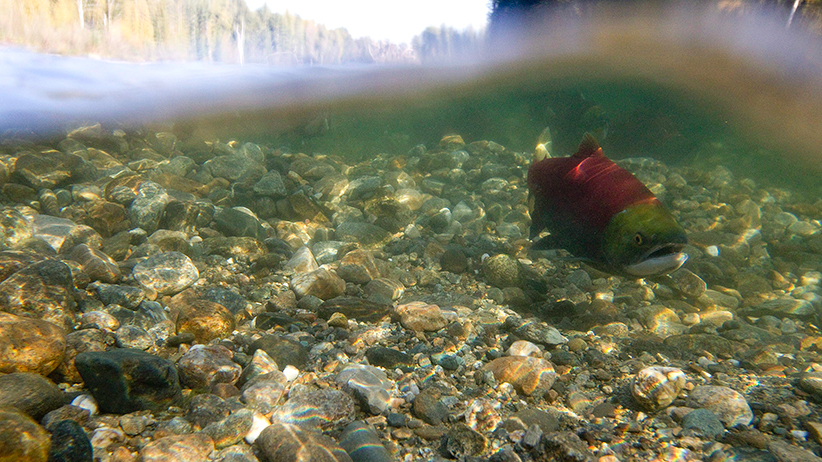New information gives salmon expert pause on mine leak impact
Carl Walters, who has been studying B.C. salmon for 40 years, finds new reason to worry about the Mount Polley leak’s effect on salmon run
A spawning sockeye salmon is seen making its way up the Adams River in Roderick Haig-Brown Provincial Park near Chase, B.C. Thursday, Oct. 7, 2010. Jonathan Hayward/CP
Share

In the wake of the tailings pond breach at British Columbia’s Mount Polley on August 4, which loosed 10 million cubic metres of water contaminated with arsenic and mercury and 4.5 million cubic metres of tiny silt silicates into Hazeltine Creek and Quesnel Lake., there were fears that it might affect a salmon run that begins in the next few weeks that the Department of Fisheries has predicted could hit historic highs. Two weeks ago, Dr. Carl Walters—a professor emeritus at the University of British Columbia’s fisheries school who has studied sockeye salmon, the most significant species in the run, for four decades—told Maclean’s that he was confident that the leak would not affect the salmon run, saying that the waste silicates would sink to the bottom or be carried out of the system quickly.
However, Walters is no longer so sure. That’s in the wake of recent conversations with scientists in the field who suggest an interflow in the Quesnel waterways may be in play.
Related from Maclean’s:
- Cleaning up after Canada’s largest tailings pond leak
- Salmon expert: Tailings pond leak won’t affect sockeye salmon run
- What you need to know about tailings ponds
“At least some of that water sank down below the warm surface layer of the lake—the materials suspended in it made it heavier than the surface water—but then rode on top of the more dense cold water,” said Walters in an email exchange. “The interflow is kind of like a layer cake: the western part of the lake now has a layer of warm clean water, on top of a layer of polluted water, and below that is a layer of cleaner deep water.”
This situation, Walters said, can worsen for the coming sockeye run given three possible conditions:
- It is common for a strong west wind to blow through the area for a day or two every few weeks this time of year, and if this happens the warm surface water will be pushed east away from the lake outlet where it can be carried out of the system, and the polluted water may surface and run downstream past Likely.
- Samples of the polluted water have shown that it has copper levels that are “close” to levels that can impair the salmon’s directional sense of smell, which the sockeye may need to move up Quesnel Lake and find their primary spawning areas in the Horsefly and Mitchell Rivers. As they move into the lake, they may seek deeper, cooler water and so will encounter the polluted, colder, dense water of the interflow layer cake. “This is especially worrisome for the Mitchell River fish that need to make a left turn about 20 km up the lake into the lake’s north arm and travel 60 km up that arm,” he said.
- About 20 km up the lake from the outlet, there is a shallow area called a sill, across which the lake water usually flows westward. That flow concentrates small plankton that feeds young salmon, but the polluted water has spread eastward enough to reach the sill, which could affect both the young fish and its food supply.
“I still don’t think it will be a serious problem, but I just can’t say for sure,” said Walters. “But at this point all we can do is to keep our fingers crossed that the polluted layer will be diluted enough by the time the main body of fish arrives so as not to be a major problem for them.”
The interflow’s effects are currently being investigated by federal and provincial scientists, and Walters expects there will be a public announcement about this soon. Imperial Metals, which owns the Mount Polley mine, was given a deadline of last Friday to submit a comprehensive report to B.C. officials, though the report has not been released.